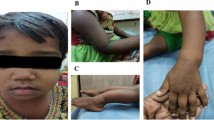Abstract
Aim
Hyperphosphatemic familial tumoral calcinosis (HFTC) is a rare endocrine disorder caused by autosomal recessive variants in GALNT3, FGF23, and KL leading to progressive calcification of soft tissues and subsequent clinical effects. The aim of this was to study the cause of HFTC in an Iranian family.
Patients and methods
Four generations of a family with HFTC were studied for understanding the genetic pattern of the disease. Whole exome sequencing was applied on genomic DNA of the proband. Based on its result, genetically altered sequences were checked in his family through sanger sequencing. Then bioinformatics approaches as well as co-segregation analysis were applied to validate the genetic alteration.
Results
A novel homozygous variant in exon four of GALNT3, namely p.R261Q was found. The parents and sister were carriers.
Conclusion
To our knowledge, it is the first-reported Iranian family with GALNT3-CDG novel variant.


Similar content being viewed by others
References
Dumitrescu CE et al (2009) A case of familial tumoral calcinosis/hyperostosis–hyperphosphatemia syndrome due to a compound heterozygous variant in GALNT3 demonstrating new phenotypic features. Osteoporos Int 20(7):1273–1278
Farrow EG, Imel EA, White KE (2011) Hyperphosphatemic familial tumoral calcinosis (FGF23, GALNT3 and αKlotho). Pract Res Clin Rheutomatol 25(5):735–747
van Tol W, Wessels H, Lefeber DJ (2019) O-glycosylation disorders pave the road for understanding the complex human O-glycosylation machinery. Curr Opin Struct Biol 56:107–118
El Demellawy D, Chang N, de Nanassy J, Nasr A (2015) GALNT3 gene variant-associated chronic recurrent multifocal osteomyelitis and familial hyperphosphatemic familial tumoral calcinosis. Scand J Rheumatol 44(2):170–172
Frishberg Y et al (2007) Hyperostosis–hyperphosphatemia syndrome: a congenital disorder of O-glycosylation associated with augmented processing of fibroblast growth factor 23. J Bone Miner Res 22(2):235–242
Smith ER, Cai MM, McMahon LP, Holt SG (2012) Biological variability of plasma intact and C-terminal FGF23 measurements. J Clin Endocrinol Metabol 97(9):3357–3365
Roberts MS et al (2018) Autoimmune hyperphosphatemic tumoral calcinosis in a patient with FGF23 autoantibodies. J Clin Investig 128(12):5368–5373
Ichikawa S et al (2010) Clinical variability of familial tumoral calcinosis caused by novel GALNT3 variants. Am J Med Genet Part A 152(4):896–903
Ichikawa S et al (2007) Novel GALNT3 variants causing hyperostosis-hyperphosphatemia syndrome result in low intact fibroblast growth factor 23 concentrations. J Clin Endocrinol Metabol 92(5):1943–1947
Tiwari V, Nagar M, Santoshi JA (2019) Hyperphosphataemic tumoral calcinosis. Lancet 12(393):168
Rafaelsen S, Johansson S, Ræder H, Bjerknes R (2014) Long-term clinical outcome and phenotypic variability in hyperphosphatemic familial tumoral calcinosis and hyperphosphatemic hyperostosis syndrome caused by a novel GALNT3 variant; case report and review of the literature. BMC Genet 15(1):98
Ramnitz MS et al (2016) Phenotypic and genotypic characterization and treatment of a cohort with familial tumoral calcinosis/hyperostosis-hyperphosphatemia syndrome. J Bone Miner Res 31(10):1845–1854
Kışla RE et al (2019) Hyperphosphatemic familial tumoral calcinosis in two siblings with a novel mutation in GALNT3 gene: experience from Southern Turkey. J Clin Res Pediatr Endocrinol 11(1):94–99
Specktor P, Cooper JG, Indelman M, Sprecher E (2006) Hyperphosphatemic familial tumoral calcinosis caused by a mutation in GALNT3 in a European kindred. J Hum Genet 51(5):487–490
Benet-Pagès A, Orlik P, Strom TM, Lorenz-Depiereux B (2004) An FGF23 missense mutation causes familial tumoral calcinosis with hyperphosphatemia. Hum Mol Genet 14(3):385–390
Sun L et al (2016) Identification of two novel mutations in the GALNT3 gene in a Chinese family with hyperphosphatemic familial tumoral calcinosis. Bone Res 4:16038
Topaz O et al (2004) Mutations in GALNT3, encoding a protein involved in O-linked glycosylation, cause familial tumoral calcinosis. Nat Genet 36(6):579–581
Garringer HJ et al (2007) Two novel GALNT3 mutations in familial tumoral calcinosis. Am J Med Genet A 143(20):2390–2396
Yancovitch A et al (2011) Novel mutations in GALNT3 causing hyperphosphatemic familial tumoral calcinosis. J Bone Miner Metab 29(5):621–625
Funding
This work was funded by Iran University of Medical Science and Genetic Foundation of Tehran under Grant no. 97-3-24-12976.
Author information
Authors and Affiliations
Contributions
M.H. and F.M. conceived and designed the experiments. I.H. and M.G carried out clinical diagnosis and treatment and interpreted clinical results. F.M., S.S., and M.H. carried out and interpreted the molecular and genetic experiments. M.H and S.S and M.G. wrote the manuscript and all authors approved the final version of it.
Corresponding author
Ethics declarations
Conflict of interest
The authors declare neither conflict competing conflicts, nor industry relationship related to this study.
Ethical approval
The research was carried out based on the Declaration of Helsinki principles. All the participants were provided written informed consent to participate and to publish data. The study was approved by the Ethics Committee of Iran University of Medical Sciences, Tehran, Iran (IR.IUMS.REC.1397.620).
Informed consent
Written informed consent was obtained for participants. The ethical committee of Ian University of Medical Science, Tehran, Iran, approved the study.
Additional information
Publisher's Note
Springer Nature remains neutral with regard to jurisdictional claims in published maps and institutional affiliations.
Rights and permissions
About this article
Cite this article
Mahjoubi, F., Ghadir, M., Samanian, S. et al. Hyperphosphatemic familial tumoral calcinosis caused by a novel variant in the GALNT3 gene. J Endocrinol Invest 43, 1125–1130 (2020). https://doi.org/10.1007/s40618-020-01203-x
Received:
Accepted:
Published:
Issue Date:
DOI: https://doi.org/10.1007/s40618-020-01203-x




